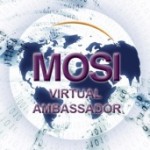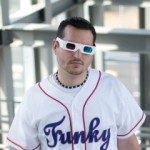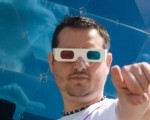Science Outreach [Fermilab]
The following is a revised version of a science outreach speech I gave at Fermilab in Batavia, IL, USA on 11 August 2009. If you love RealPlayer, science and rap, please consider watching the speech recording by the fine people at Fermilab. [Science Outreach via Rap speech]
Steven Rush speak at Fermilab
My name is Steven Rush and I’m fan of both hip-hop and science. As a kid I had one of those 1980′s huge boomboxes and a microscope. Today I produce music under the name funky49 and have performed at music festivals like Nerdapalooza. Earlier this year I made an album called Rapbassador to promote Tampa’s Museum of Science and Industry. Rapbassador combines the words rap and ambassador. By combining two of my interests, science & music, I saw myself as peoples gateway to Tampa’s MOSI. I could also see this album as being a science enthusiast’s gateway to hip-hop. Dr. Kilminster from the CDF team found a write-up about Rapbassador and asked me to write a rap song for Fermi National Accelerator Laboratory.
But what is rap? Rap is one of the elements of hip-hop. Hip hop is a culture of the streets coincidentally born in the same area of the planet as Dr. Leon Lederman. The South Bronx, New York City. Today, rap is one of the most popular music genres of the world. I propose if music had a “Grand Unifying Genre”, rap music would be it. Rap songs can be created by adapting elements from any other style of music. This is because rap is inclusive musically and lyrically. Rap music is so accessible; it can be done simply by someone rhyming off the top of the heads in a stream of consciousness like flow. Lyrical topics can be broad as the mind of the writer. Topics such as science. Chuck D is quoted as saying that “rap is the CNN for black America”. I’m about to tell you about some people who are using rap as the science news network for all of America… and the rest of the world.
Coming straight out of Europe is the Large Hadron Rap by Kate McAlpine. McAlpine who raps under the name “Alpinekat” is an online journalist and webmaster for CERN. She crafted her rhymes about the Large Hadron Collider to be highly explanatory and clean for classrooms. She helped spread knowledge of the LHC and particle physics to a lot of people. As August 2009, the LHC Rap has over 5 million YouTube hits. This was so popular worldwide it was translated into Spanish and Portuguese and subtitled into French and Dutch. The LHC rap was also inspirational. Girls from a London high school made a rap to explain different kinds of radiation. This film went on to win the Institute of Physics Best Physics Film 2009. Truly McAlpine has been able to use rap to educate and inspire!
From New York City is Dr. Chris Emdin, a science education professor at Columbia University. He is teaching teachers on how to incorporate rhymes in their science classes. With his method, teachers craft information into rhymes that are delivered to the students. Students are driven to thoroughly learn their classroom material so they are more competitive in rhyme matchups with each other. Here, rap is a common element in the students’ lives and is being used as a fun, educational aid. ABC News
I’d like to preference this next example with Dr. Stephen Hawking saying that he is “flattered on an odd sort of way”. Based on the web and mixing science, rap and humor is MC Hawking. MC Hawking is a parody of both gangster rap and of Dr. Stephen Hawking complete with vocals delivered via computer generated speech. Lyrics include “I explode like a bomb. No one is spared. / My power is my mass times the speed of light squared.” and has songs entitled “F___ the Creationists” and “What we need more now is science“. Rap music is used here to entertain and reinforce existing scientific knowledge.
A real rapper from Great Britain is Jonathan Chase aka Oort Kuiper. Two of his degrees are in aerospace engineering and science communications. His specific goal is to make scientific ideas more accessible. In 2008, a NASA-sponsored online magazine asked this London born post-graduate to create his “Astrobiology rap“. A seventh grade teacher commented that he found Oort Kuiper’s song awesome, super-catchy and informative. NASA’s Johnson Space Center interns created a rap about the International Space Station with I.S.S. Baby. NASA and the NSF produced a rap song called “Take Aim at Climate Change“. The University of New Hampshire has a program that monitors the marine ecosystem in the Gulf of Maine. They did a rap song that sums up events they’ve experienced on observation cruises and called it Cruise, Cruise Baby. No matter what the scientific discipline, it can be adapted to fit in the framework of rap delivery.
Evergreen State College in the state of Washington has a program called “Sound Science”. It’s a new spin on field biology in the forest canopy. Think of an embedded rapper on a field trip. C.A.U.T.I.O.N. the rapper would supplement lessons given by the instructors and do things like climb 60 foot trees. Back in the classroom, students would read science encyclopedias and natural history magazines to help create their own rap songs and spoken word poetry. At the end of the first instantiation of this program, 90% of the students described scientific learning as “fun”. Rap can complement existing lessons and make learning fun. “Ecology” is an example of C.A.U.T.I.O.N.’s work.
Tampa’s MOSI and I were able to generate more local and online coverage for the museum. Without this coverage, including a write-up in ScientificBlogging, I would never have been invited to work with Fermilab. The album is a treat for the paid and volunteer staff. Most are very surprised when they find MOSI has its own rap album. Song topics include MOSI itself (MOSI Got the Party), its IMAX theater (That’s Not IMAX) and a call for ecological sustainability (The Future is Calling). Rapbassador featured me rapping over techno, punk as well as traditional rap music. Please download and give the Rapbassador EP a listen
From Brooklyn, NY we have a duo that are making money creating raps for the classroom. They are called Flocabulary. They’re used in over 10,000 schools in the US. They’re a current-day incarnation of School House Rock. Likewise, Flocabulary have albums about the English language arts, social studies, math and science. With the success of Flocabulary, teachers have spoken with their budget dollars. Rap music belongs in the class room. Check out their song, Confessions of a Planet.
Rap can engage others in science and make them part of the lesson. Rap can be used to inform, entertain, make science accessible, is adaptable in its subject matter and has a low barrier for participation. To paraphrase Dr. Emdin, “Science no longer should be perceived as belonging to those beyond the urban classroom.” Along with myself, Kate McApline, science-rappers previously mentioned and others out there on the web, science belongs to more people because of its integration with rap music. When science education and rap music collide, the result is not annihilation of both. Something new is created.
Addendum: There were some ‘honorable mentions’ I was not able to put into the speech. They include the Physics Guy Rap, “Rhythm, Rhyme, Results” (who are like Flocabulary), Buzz Aldrin’s “Rocket Experience” with Snoop Dogg. Chemical Calisthenics by Blackalicious. Origin of the Species by MC Frontalot. Kill Dash Nine by Monzy. Clouds Make It Rain by tomcfad. Also please check out the science-rap portfolio of Kate McAlpine. If you come across or make something good, please post it here for others to find as well!












